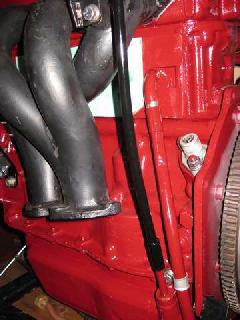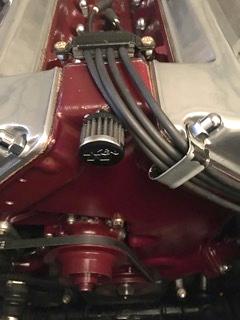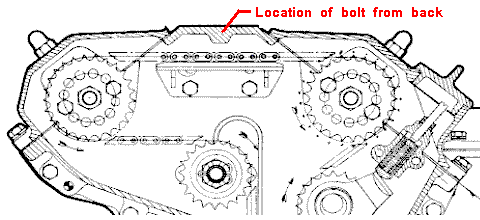The MGA With An Attitude
CRANKCASE VENTILATION for the Twin Cam #1 - TC-335A
 The question comes up occasionally about why the MGA Twin Cam engine does not have crankcase ventilation? Yes it does have a draft tube on the rear side cover that serves to relieve pressure from the crankcase, but there is no fresh air inlet vent anywhere on this engine.
The question comes up occasionally about why the MGA Twin Cam engine does not have crankcase ventilation? Yes it does have a draft tube on the rear side cover that serves to relieve pressure from the crankcase, but there is no fresh air inlet vent anywhere on this engine.
As a quick review, burning gasoline and oxygen from the air produces heat, carbon dioxide and water vapor. To the extent that some of the combustion gases can sneak past the piston rings, the water can condense to collect in the crankcase, along with other acids and particulates that can dilute the oil and dirty up the inside of the engine. Water vapor can also condense inside the valve covers (coolest part of the engine) where you may notice it collecting like dirty mayonnaise. That is emulsified water and oil making the scum under the oil filler cap. If it condenses enough water there it can ultimately rain inside the crankcase to drop liquid water into the sump. Other kinds of "dirt" from combustion gases can accumulate anywhere to dirty up the inside the engine, including accumulating a deep layer of sludge in the sump if the oil is not changed often enough.

As such, it is a good idea to allow filtered fresh air to enter the crankcase, to pass through the crankcase and exit via the draft tube. This fresh air ventilation serves to purge water vapor and other pollutants from the crankcase before they can settle out to cause problems. Other MG engines of the pushrod variety do have a fresh air intake from the air cleaner to the valve cover, but not so on the Twin Cam engine.
Here is a picture of a nice modification to add an intake air filter near the top of the timing chain cover. It is a neat and cheap commercial air filter, requiring drilling a hole in the timing cover, and not needing to run a hose to the carburetor air cleaner. The filter has a rubber neck on the back which is secured to the new vent tube with a hose clamp (easy to change the filter).
On March 5, 2020 Ulrich Armbrust wrote:
"The top bolt that secures the timing cover to the engine front plate screws into a “tube” cast into the timing cover, which is tapped at the rear. This tube runs all the way across [back to front]. I opened it from the front and tapped it to accept a short length of 5/16 tube. Then just drilled into the cast “tube” at a 90 degree angle from the inside of the timing cover to create an opening, which is indirect and splatter proof. It is large enough and has been working well".

There is a hole in this rib that is tapped from the back to accept the top bolt through engine front plate into timing cover. You can drill this hole through to front to accept the new vent tube. Then drill the rib from bottom to vent this hole through into the crankcase. Of course the timing cover must be removed to do this.
I am a little concerned about the small size of the new vent tube. If it has a 5/16-24-UNF male thread into the timing cover, the tap drill size is Letter-I, 0.272". Root diameter of the male thread is slightly smaller at 0.262". To have minimal strength in the tube it must have ID no larger than about 0.200", barely over 3/16" ID, or smaller. If the new vent tube could be press fit into the casting without threads, the ID could be larger, as much as 0.250 (1/4"). Even then it is 1/2 the diameter and 1/4 the flow capacity of the 1/2-inch draft pipe. But a little fresh air is better than none.
|